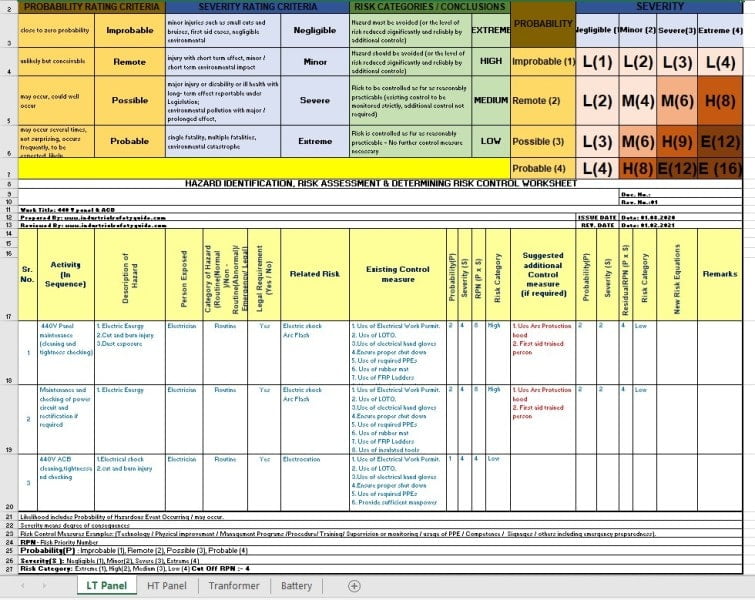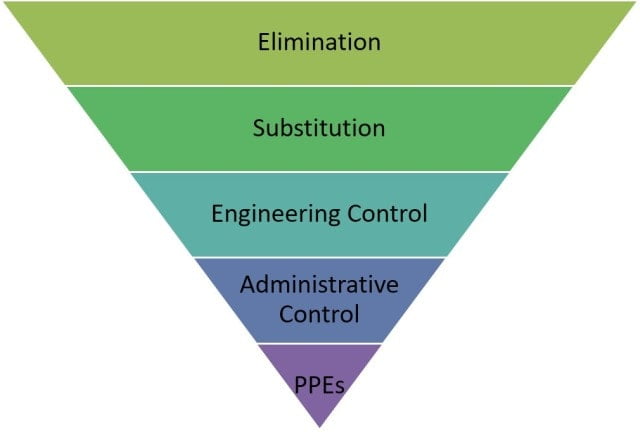Table of Contents
What is hazard identification?
Hazard identification is one of the essential elements of the health and safety management system. Hazard identification is also known as HAZID and hazard identification is the process of finding hazards. Hazard identification is the foundation for developing safe work procedures and it is the first step in the risk assessment process. It identifies sources and causes of hazards.
Hazard identification methods
- Conducting pre-start discussions on the work to be carried out.
- Encouraging workers to recognize and highlight hazards while performing work.
- Carrying out safety inspections and audits of the workplace and work procedures.
- Conducting job safety analyses (or similar task evaluation processes).
- Monitoring, measuring, and testing the working environment, such as noise monitoring, electrical testing, and atmospheric testing.
- Analysing proposed new or modified plant, material, process, or structure.
- Conducting hazard (or risk) surveys.
- Reviewing product information, e.g. Safety data sheets, operating manuals.
- Researching publicly available data on hazards, e.g. Media articles, industry, or safety regulator alerts and
- Looking at the past incidents and near-miss reports.
Unsafe acts and unsafe conditions must be observed to find out hazards. Unsafe acts due to psychological and physiological personal factors should be detected. Hazards of unsafe conditions are mechanical, electrical, chemical (including radiation), and environmental. Some hazards are visible and some are invisible.
What is visible hazard and how it is detected?
- Plant inspection based on the statutory requirement, checklist, safety survey, safety audit, and safety sampling
- Detection and monitoring systems
- Functional test of machinery and equipment
- Accident investigation
- Repair shop
- Store consumption and
- Shop feedback etc.
Examples of visible hazards:
- Unguarded machinery
- Bad housekeeping
- Wrong practices etc.
What is invisible hazard and how it is detected?
Invisible hazards like gas leaks, the concentration of toxic and hazardous vapor, malfunction or failure of machinery, equipment, pressure plants, and miscellaneous environmental factors may cause a sudden accident and heavy damage. They must be detected and controlled by built-in self-corrective systems. The devices used are detectors, recorders, alarms, trips, probes, sensors, limit switches, meters, analyzers, electronic or auto controls, scrubbers, incinerators, etc.
What is risk?
Risk is the chance that can lead to the potential consequences or risk is the probability of an undesired event occurring within a specified period or under specified circumstances and its severity effects on consequences.
What is risk assessment?
Risk assessment is a systematic and structured process whereby hazards present in a workplace are identified, evaluated and corrective actions are prioritized to eliminate or reduce risks to acceptable levels. Risk assessment is not for tasks where the hazards or risks are obvious and well-known and clearly understood.
Risk assessment is the backbone of the environmental and safety management system. Risk assessment is the crucial starting point for all health and safety decisions. If it is not done properly and systematically, all action, which is taken in health and safety management, could be ineffective.
Risk assessment steps:
- Look for the hazards.
- Decide who might be harmed and how.
- Evaluate the risk and decide whether the existing precautions are adequate or whether more should be done.
- Record your findings.
- Review your assessment and revise it if necessary.
Benefits of risk assessment:
- Eliminate most serious hazards.
- Fulfill Regulatory & Policy requirements.
- Involves teams from all levels in the organization.
- Focus on the actual work activities.
- Improve awareness of hazards and/or identify new ones.
- Ensure that the correct “control measures” are in place and reflected in proper job procedures.
- Continuously improve Safety Management systems and conditions of work.
- Reduce Safety incidents.
What is Hazard identification and risk assessment (HIRA)?

Hazard identification and risk assessment is a process where hazards present in the workplace are identified evaluated and corrective actions are taken to eliminate or reduce risk.
When Hazard Identification and Risk assessment is required:
- Proper safety procedures are not in place.
- Existing procedures are not adequate.
- When New job, task, chemical, and/or machine has been introduced.
- The existing task has been changed significantly.
- New/ different people doing the task.
- Changes in technology.
- Unplanned work.
- To continue work after an incident or injury has occurred.
- Result of medical surveillance.
When Hazard Identification and Risk assessment is required examples:
- High-pressure cleaning.
- Confined space Entry.
- Line Break.
- Working at heights.
- Deviations from procedures and SOP.
- Rigging & Hoisting.
- Hot Work (flames/sparks).
- New tasks/jobs etc.
Hierarchy of hazard control measures

- Elimination.
- Substitution.
- Engineering Control.
- Administrative Control.
- Personal Protective Equipment.
Examples of Elimination
- Lockout equipment.
- Install blind /blank.
- Modify process to eliminate the need for hazardous activity (e.g auto sampling).
- Fully automate the process.
Examples of Substitution
- Use alternate materials (e.g. lower flash point).
- Use tools instead of handling with bare hands.
- Use trolley and truck (instead of carrying).
- Automate process.
Examples of Engineering Control
- Installing interlocks.
- Modifying equipment.
- Use special tools for the job.
- Redesign workplace layout.
- Install noise enclosure.
- Machine guarding.
Examples of Administrative Controls
- Implementing permit-to-work system.
- Barricading area.
- Job rotating (to reduce fatigue).
- Following job procedures /work instructions.
- Working in pairs.
- Testing for hazardous atmosphere.
Examples of Personal Protective Equipment
- Wearing safety harness.
- Wearing Kevlar gloves
- Wear respirators, etc.
Related Topics:
